Pamukkale is a truly miraculous landscape located in the city of Denizli in western Turkey. Translating into ‘Cotton Castle’ in Turkish, its striking white hills and waterfall formations result in a fairy tale scenery.
This guide outlines everything you need to know about the stunning travertines of Pamukkale.
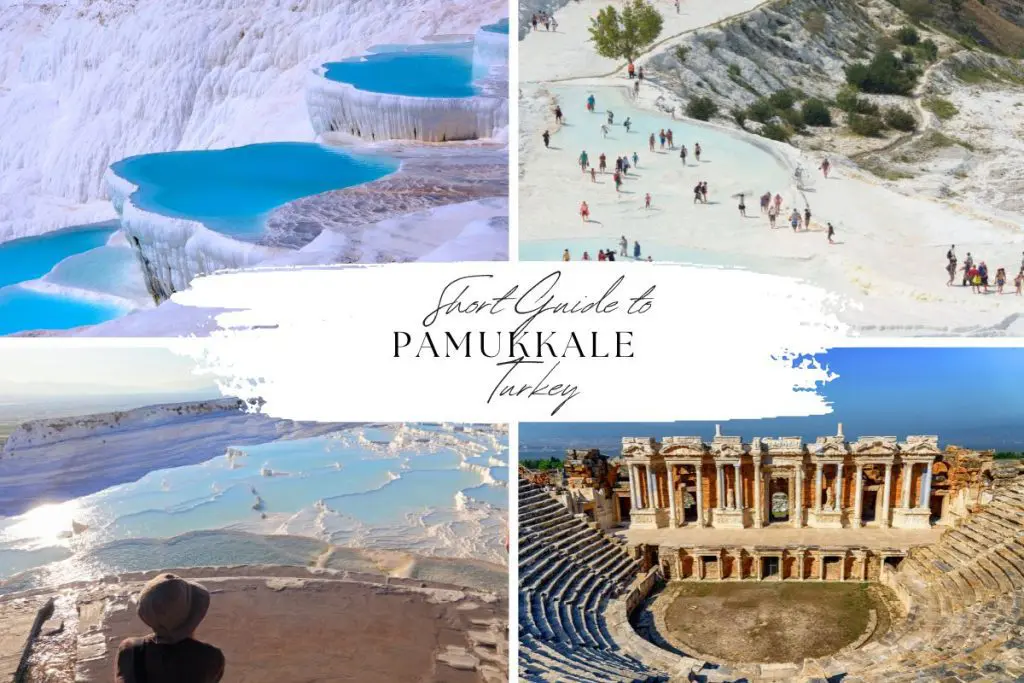
What is Pamukkale?
As one of the best loved natural wonders of Turkey, it’s not difficult to see why it’s so popular. This unique and mysterious phenomenon is built up of beautiful white and turquoise terraces.
Pamukkale is a formation of sedimentary rocks that resulted from the thermal spring’s mineral water. These rocks are calcium rich and are called limestone ‘travertine’. As a result, visitors are magnetised by the crystal pools and ivory hills of cascading water. Visitors come here to admire it’s beauty, dip in the thermal springs and check out the ‘Holy City’ Hierapolis.
Interesting facts about Pamukkale
Pamukkale thermal pools
Pamukkale is renowned for its captivating Pamukkale thermal pools. Here are some fascinating facts about this natural wonder:
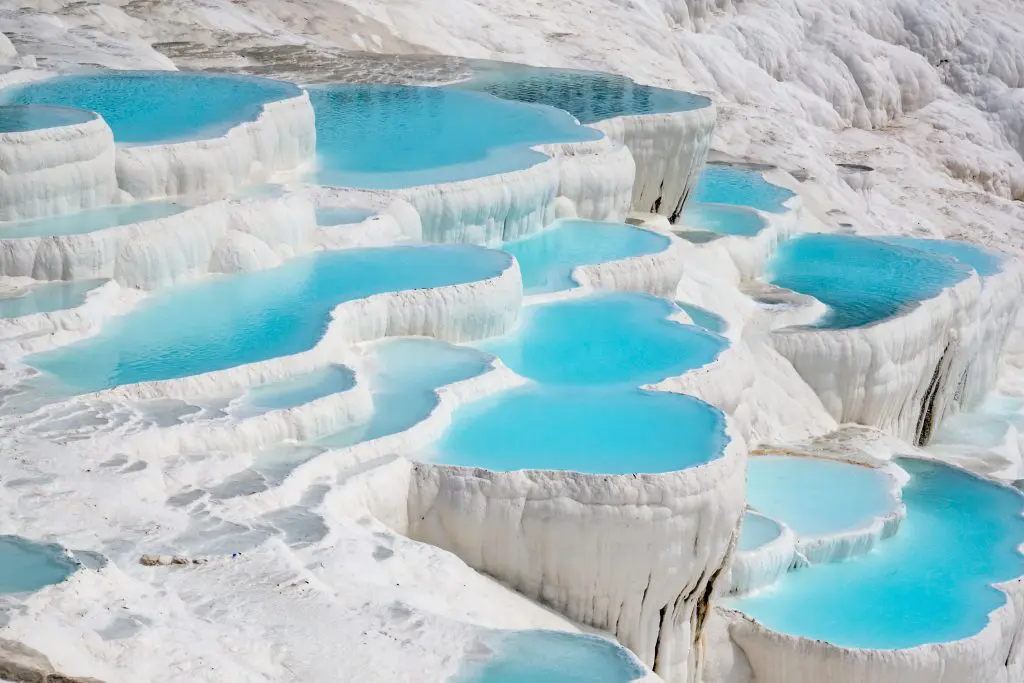
Formation: The mesmerizing terraces of Pamukkale thermal pools were shaped over thousands of years as mineral-rich hot springs, containing calcium carbonate, cascaded down the hillsides and solidified, creating the unique terraced pools.
UNESCO World Heritage Site: Since 1988, Pamukkale, along with the adjacent ancient city of Hierapolis, has held the prestigious designation of a UNESCO World Heritage Site, acknowledging its cultural and natural significance.
White Cotton Castle: The Turkish name “Pamukkale” translates to “cotton castle,” a fitting descriptor for the striking white terraces that resemble a cascading cotton fortress.
Hierapolis: Positioned atop the Pamukkale terraces, the ancient city of Hierapolis served as a thriving Roman and Byzantine spa city. Visitors to Pamukkale have the opportunity to explore well-preserved ruins, including a Roman theater, temples, and a necropolis.
Thermal Waters: The Pamukkale thermal pools are famous for their healing properties, attributed to the high mineral content in the thermal waters. For centuries, people have sought these waters for their reputed therapeutic benefits.
Calcium Travertines: Composed of white travertine, a form of limestone deposited by the flowing water, the Pamukkale thermal pools create a visually stunning and ethereal landscape, drawing visitors from all corners of the globe.
Cleopatra’s Pool: Within the archaeological site of Hierapolis, the expansive Cleopatra’s Pool is fed by the same thermal springs that shaped the iconic terraces. Visitors can swim amidst ancient ruins, adding an extra dimension to the Pamukkale experience.
Conservation Efforts: Acknowledging the environmental impact of increased tourism, conservation efforts are underway to protect Pamukkale. Restricted access to certain areas and the requirement to remove shoes are measures implemented to preserve the integrity of the travertines.
Tourist Attraction: Pamukkale thermal pools have become a magnet for tourists worldwide, luring them with the promise of natural beauty, ancient history, and the chance to bask in the therapeutic warmth of the thermal waters.
Visiting Tips: To fully appreciate the allure of Pamukkale thermal pools, it is advisable to visit during the early morning or late afternoon, avoiding midday crowds and harsh sunlight. Swimsuits are permitted in designated areas, allowing visitors to immerse themselves in the rejuvenating experience of the thermal pools.

Cotton Castle Pamukkale Turkey
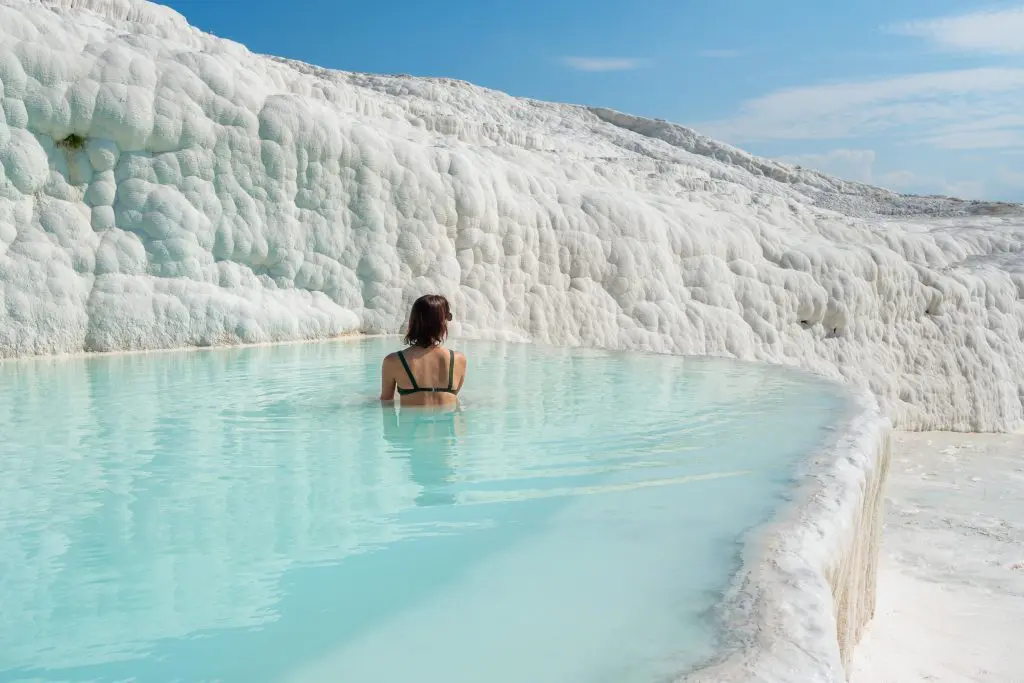
Pamukkale, often referred to as the “Cotton Castle,” is a captivating natural wonder in the Denizli Province of southwestern Turkey. The site’s unique terraces, resembling a cascading castle made of cotton, have been formed over centuries by the flow of mineral-rich thermal waters. The name “Pamukkale” translates to “cotton castle” in Turkish, reflecting the bright white color of the travertine terraces against the surrounding landscape.
This extraordinary landscape, along with the adjacent ancient city of Hierapolis, holds UNESCO World Heritage Site status, acknowledging both its cultural and natural significance. Hierapolis, perched atop the Pamukkale terraces, boasts well-preserved ruins, including a Roman theater, temples, and a necropolis.
The thermal waters flowing down the travertines of Pamukkale are renowned for their high mineral content, believed to possess therapeutic properties. Visitors have been drawn to Pamukkale for centuries to experience the warm and rejuvenating nature of these springs.
The terraces form a series of stepped pools, creating a stunning visual display as the flowing water continuously shapes the travertine surface. Conservation efforts have been implemented to protect Pamukkale, including measures to restrict access to certain areas and the requirement for visitors to remove shoes, ensuring the preservation of this delicate natural wonder.
As a major tourist attraction, Pamukkale offers a unique experience where visitors can explore the terraces, swim in designated areas like Cleopatra’s Pool, and immerse themselves in the harmonious blend of natural beauty and ancient history. To optimize the visit, it is advisable to arrive early in the morning or late in the afternoon to avoid crowds and capture the terraces in optimal lighting. Pamukkale stands as a symbol of the seamless convergence of geothermal wonders and the rich history of an ancient civilization.
Holy City – the Ancient Hierapolis Pamukkale Turkey
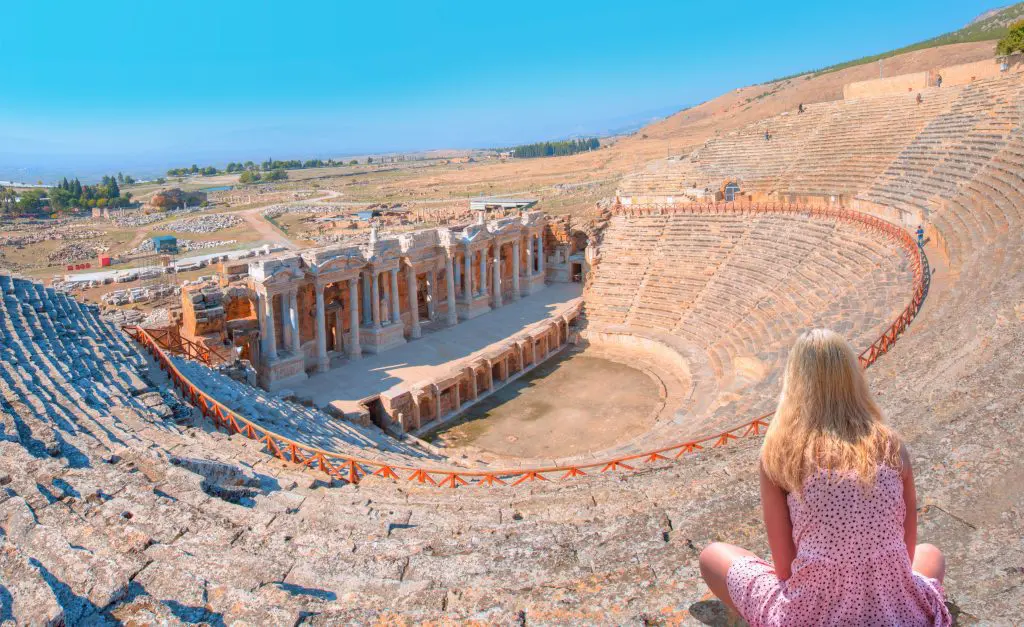
Hierapolis, the ancient city crowning the terraces of Pamukkale, holds deep historical significance. Its origins date back to the Hellenistic period, possibly founded by Antiochus II in the 2nd century BCE. Positioned strategically along trade routes and near thermal springs, the city thrived under Roman rule, transforming into a renowned spa and healing center. Monuments such as the impressive Roman theater, the Temple of Apollo, and an extensive necropolis bear witness to the city’s cultural and religious prominence.
During the Byzantine era, Hierapolis continued to prosper as a Christian hub. It became a bishopric, and the necropolis became a resting place for Christian martyrs. Numerous churches, including the Martyrium of St. Philip, were erected, contributing to the city’s Christian heritage.
The Roman theater, a testament to Hierapolis’ cultural vibrancy, offers breathtaking views of the surroundings. The necropolis, with its elaborate tombs and funerary monuments, provides a glimpse into the social and religious practices of the time. The Temple of Apollo, though not fully preserved, echoes the city’s dedication to various deities.
In 1988, UNESCO recognized the combined cultural and natural significance of Hierapolis and Pamukkale, designating them as a World Heritage Site. Today, visitors can explore the well-preserved ruins of Hierapolis, immersing themselves in the layers of history, from its Hellenistic origins to its role as a Roman spa city and later, a Christian center. Hierapolis, the Holy City, stands as a captivating testament to the diverse civilizations that have shaped this remarkable site.
Hot Spring in Pamukkale Turkey
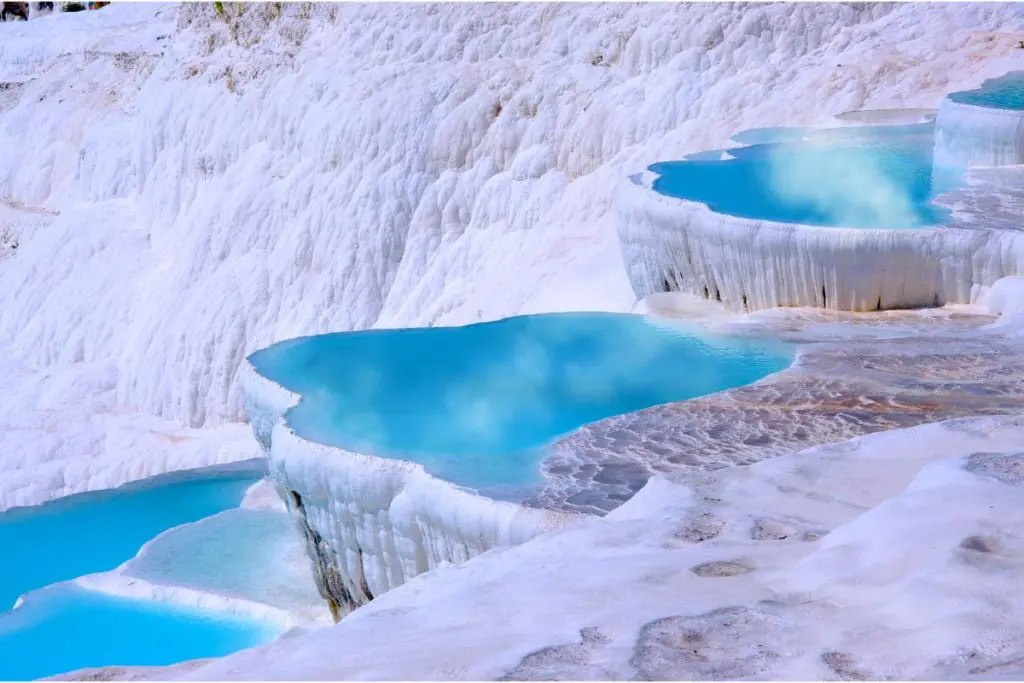
Nestled in the picturesque landscape of Pamukkale, the hot springs in Pamukkale offer a unique and rejuvenating experience for visitors. Known for their therapeutic properties, the hot springs in Pamukkale have been drawing people for centuries, seeking the healing benefits of the mineral-rich waters.
The terraces of Pamukkale, often referred to as the Cotton Castle, are adorned with these natural thermal pools, creating a stunning visual display. As visitors explore the terraces, they can also immerse themselves in the warm embrace of the hot springs in Pamukkale, which are believed to promote relaxation and skin rejuvenation.
The hot springs in Pamukkale are formed by the flow of geothermally heated water containing a high concentration of minerals, including calcium carbonate. This unique composition is said to have various health benefits, making the hot springs a sought-after destination for wellness enthusiasts and those in search of natural healing.
One can experience the therapeutic effects of the hot springs in Pamukkale in designated areas where visitors are allowed to bathe in the warm mineral waters. The sensation of soaking in these natural pools, set against the backdrop of the dazzling white terraces, creates an unforgettable and tranquil atmosphere.
In addition to their wellness offerings, the hot springs in Pamukkale also contribute to the unique charm of the UNESCO World Heritage Site. Visitors are not only treated to the historical and natural wonders of the terraces but also have the opportunity to indulge in the soothing embrace of the hot springs in Pamukkale.
As the word spreads about the hot springs in Pamukkale, the region continues to attract travelers seeking a harmonious blend of cultural exploration and therapeutic relaxation. Immerse yourself in the warm waters and let the unique healing properties of the hot springs in Pamukkale enhance your visit to this extraordinary natural wonder.
Pluto’s Gate (Gate to Hel) Hierapolis
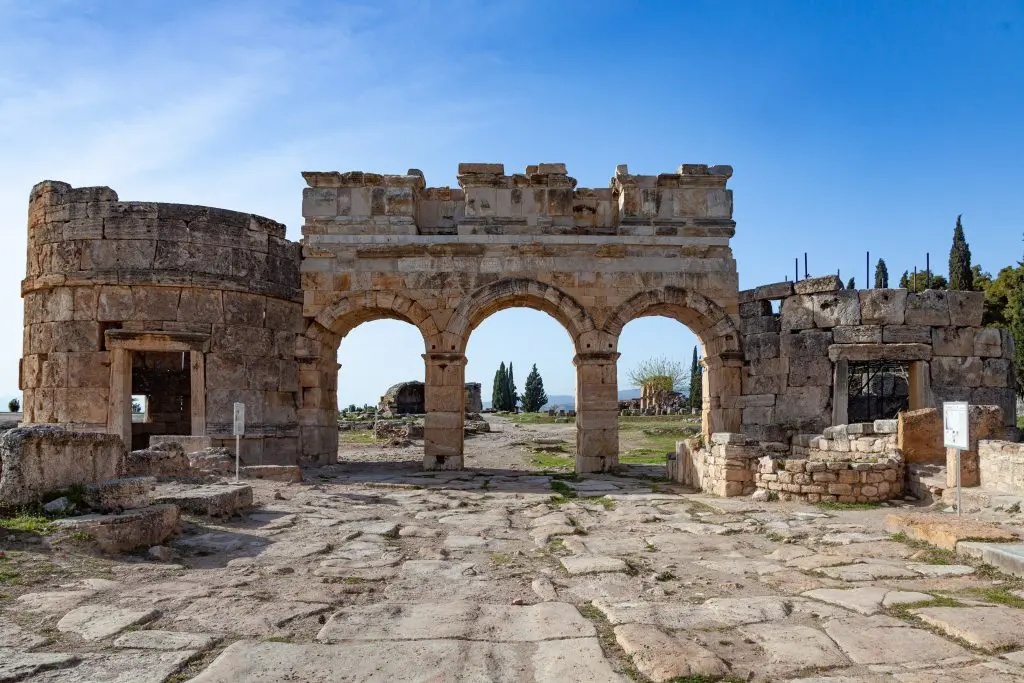
Pluto’s Gate, also known as the Gate to Hell, holds a fascinating place in the historical and mythological tapestry of Hierapolis in Pamukkale. This ancient site is shrouded in both historical significance and mythical allure.
Located in the ancient city of Hierapolis, Pluto’s Gate is an archaeological site where a cave was believed to be an entrance to the underworld in ancient Roman and Greek mythology. The site gained its association with the god Pluto, the ruler of the underworld in Roman mythology, and his Greek counterpart, Hades.
The ancient city of Hierapolis itself, positioned on the terraces of Pamukkale, was known for its thermal springs and was considered sacred. The presence of this mythological portal to the underworld added a layer of mystique to the city.
According to historical accounts, the geothermal activity in the area released carbon dioxide, making the cave a potentially lethal space. The ancient priests of Hierapolis are said to have utilized this natural phenomenon to convince pilgrims of the cave’s mystical powers.
While the cave was not an actual gateway to the underworld, the belief in its supernatural properties persisted. Pilgrims and seekers of oracles would visit the site, and sacrifices were made to appease the gods. The cave itself became associated with rituals and ceremonies linked to the afterlife.
The ruins of Hierapolis, including the site of Pluto’s Gate, are now part of the UNESCO World Heritage Site of Pamukkale. Visitors can explore the archaeological remains, including the remnants of this ancient belief in the mythical connection between the living and the underworld.
Today, the historical significance and mythical allure of Pluto’s Gate contribute to the unique charm of Hierapolis in Pamukkale. Visitors can wander through the ancient city, marvel at its well-preserved ruins, and contemplate the historical and mythological layers that make this site a captivating destination. The ancient city, with its connection to the mythical entrance to the underworld, stands as a testament to the rich tapestry of beliefs and cultures that have shaped the region over the centuries.
FAQs about Pamukkale
Pamukkale is a natural wonder in southwestern Turkey known for its stunning white terraces of travertine, created by mineral-rich thermal waters. It is famous for its unique geological formations and the ancient city of Hierapolis
Pamukkale is accessible by air, with the nearest airport being Denizli Cardak Airport. Alternatively, visitors can opt for a bus or car from major cities like Izmir or Antalya.
The best time to visit Pamukkale is during the spring (April to June) and fall (September to November) when the weather is mild. Summer can be hot, and winter may bring cooler temperatures.
Yes, there is an entrance fee to access the travertine terraces of Pamukkale. The fee also includes entry to the Hierapolis archaeological site.
While swimming is not allowed in most parts of the travertine terraces to preserve the site, visitors can experience the thermal waters in designated areas such as Cleopatra’s Pool within the Hierapolis site.
Comfortable clothing, a hat, and sturdy walking shoes are recommended. If you plan to visit Cleopatra’s Pool, bring swimwear. Additionally, sun protection like sunscreen is advisable.
Photography is generally allowed in most areas, but there might be restrictions in certain sections to protect the travertines. It’s essential to respect any signage indicating photography limitations.
Drinking the thermal water is not recommended, as it may contain high mineral concentrations. It is primarily meant for external use, such as bathing.
Yes, Pamukkale is suitable for families, but it’s important to supervise children, especially near the terraces. Some areas may be uneven, so sturdy strollers are advisable.
Related Contents:
 February Sale; 2 For 1
February Sale; 2 For 1  Croatia Sailing : 2 For 1
Croatia Sailing : 2 For 1 Asia Tours : 2 For 1
Asia Tours : 2 For 1 Central & Eastern Europe Tours: 2 For 1
Central & Eastern Europe Tours: 2 For 1  Why Travel Talk
Why Travel Talk Travel Talk Blog
Travel Talk Blog Responsible Travel
Responsible Travel Fair Travels with Travel Talk
Fair Travels with Travel Talk